 | ||
The Thai Canal, also known as Kra Canal or Kra Isthmus Canal, refers to proposals for a canal that would connect the Gulf of Thailand with the Andaman Sea across southern Thailand. It is envisaged that such a canal would improve transportation in the region, similar to the Panama Canal and Suez Canal.
Contents
- History
- Recent plans
- Impact on Malaya and Singapore
- Geography
- Competition with Strait of Malacca
- References

The canal would provide an alternative to transit through the Straits of Malacca and shorten transit for shipments of oil to Japan and China by 1,200 km. China refers to it as part of its 21st century maritime Silk Road. Proposals for the canal in 2015 measure 102 km long, 400 meters wide and 25 meters deep. Plans for a canal have been discussed and explored at various times, but have not been implemented. Cost and environmental concerns have been weighed against the potential economic and strategic benefits.
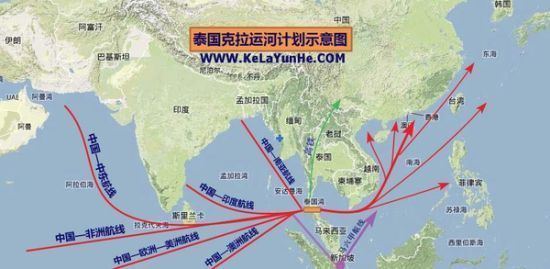
History
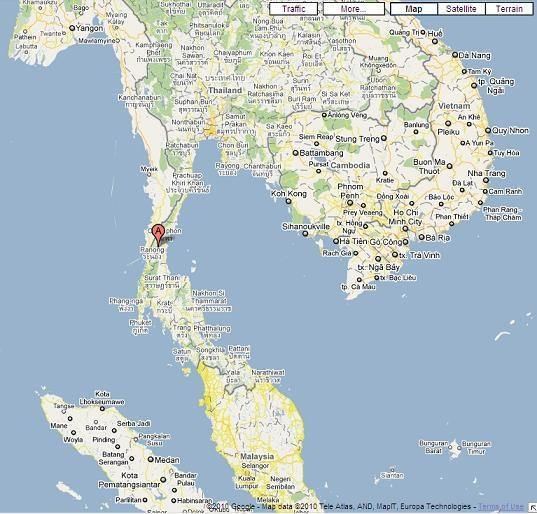
A canal through the Kra Isthmus, which would shorten shipping times around Asia, was suggested as early as 1677. Thai King Narai asked the French engineer de Lamar to survey the possibility of building a waterway to connect Songkhla with Marid (now Myanmar), but the idea was discarded as impractical with the technology of that time.
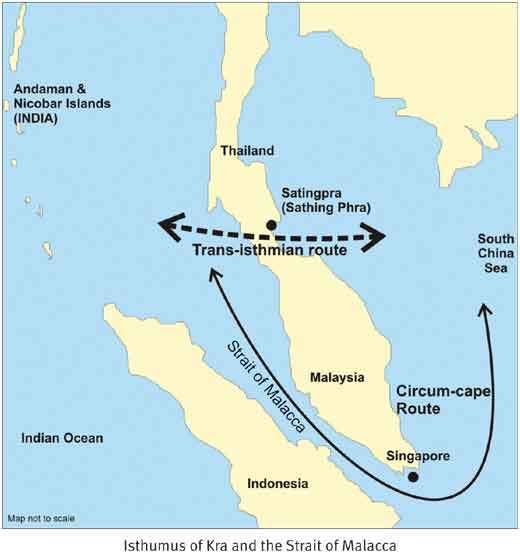
In 1793, the idea resurfaced; the younger brother of King Chakri (Rama I) suggested it would make it easier to protect the west coast with military ships. In the early 19th century, the British East India Company became interested in a canal. After Burma became a British colony in 1863, an exploration was undertaken with Victoria Point (Kawthaung) opposite the Kra estuary as its southernmost point, again with negative result. In 1882, the constructor of the Suez canal, Ferdinand de Lesseps, visited the area, but the Thai king did not allow him to investigate in detail. In 1897, Thailand and the British empire agreed not to build a canal so that the regional dominance of the harbour of Singapore would be maintained.
Recent plans
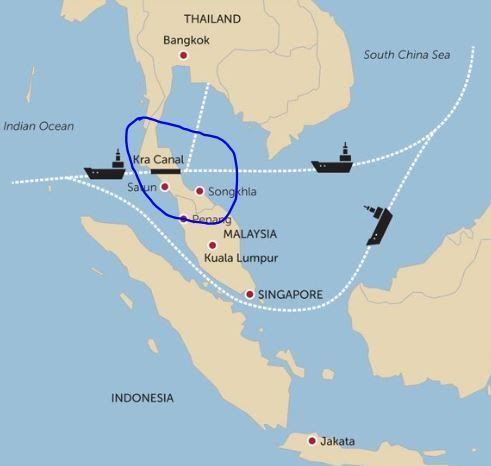
The idea of a Kra Isthmus canal has been vetted in modern times since the 1930s, but has never materialized due to high cost and environmental repercussions.
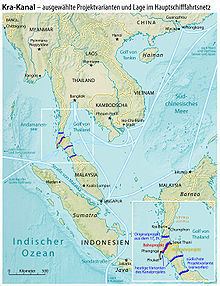
In the 20th century the idea resurfaced, including with a route in southern Thailand connecting Bandon Bay near Surat Thani with Phang Nga. Another proposed site is across Nakhon Si Thammarat and Trang Provinces. If completed, it is believed that the canal would bring an economic boost to the nearby area and benefit Thailand.
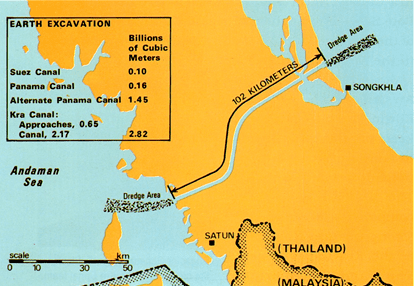
Canal opponents have raised several objections to the construction of a canal: 1) A canal will divide the country physically and pose a security risk; 2) Demand for transit will not meet expectations; 3) The excavated soil will need to be dealt with; and 4) Environmental concerns. It is also feared that a canal would separate the four southern-most provinces from the rest of Thailand and allow secessionist movements to further develop.
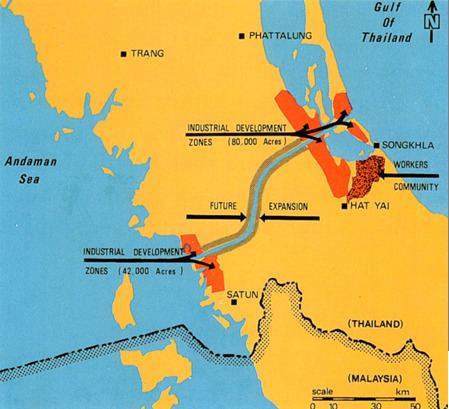
The Strait of Malacca, just under 1,000 kilometres (620 mi) long, is narrow, less than 2.5 kilometres (1.6 mi) at the narrowest, and just 25 metres (82 ft) deep at its shallowest point. It is used by many oil tankers, bulk carriers and container ships. It is estimated that some 80 percent of Japan's and South Korea's oil and natural gas supplies pass through the Strait. A canal in Thailand would mean that large ships could travel through the region from India and on to China and Japan without passing through the Strait of Malacca.
As a substitute the construction of a land bridge was started in 1993, however as the location of the harbours was not fixed, highway 44 as the only finished part of the project now does not end at the sea yet. The two lanes were built 150 m apart to leave space for a rail-road and eventually also a pipeline. Right now the highway runs from 8°18.11′N 98°47.03′E to 9°9.47′N 99°31.02′E and the project is stalled due to environmental concerns.
In 2005, an internal report prepared for U.S. Secretary of Defense Donald Rumsfeld was leaked to The Washington Times, spelling out China's strategy of underwriting construction of the canal across the Kra Isthmus, Chinese port facilities and refineries, as part of its "string of pearls" strategy of forward bases and energy security. The Chinese plan called for construction over ten years employing roughly 30,000 workers and at a cost of between US$20–25 billion.
In early-2015, calls for yet another feasibility study of the canal have been put forward, a leading proponent being the Thai-Chinese Culture and Economic Association of Thailand (TCCEAT). Supporters of the canal believe that it would end Thailand's economic slump and make it a "global shipping and economic hub, rivalling the Panama Canal". On 15 May 2015, a memorandum of understanding was signed by the China-Thailand Kra Infrastructure Investment and Development company / 中泰克拉基础设施投资开发有限公司 in Guangzhou to advance the project. On 19 May 2015 the Thai government denied reports that an agreement had been signed with China to construct the canal. The canal would take an estimated ten years to complete at a cost of US$28 billion.
According to Larouche PAC the Chinese had completed a feasibility study by 2016, but were waiting for Thai Government endorsement. On 17 January 2017, Larouche advised that a book written by leading Thai supporters of the project, including some former Thai military had been published. They hoped that the new King would endorse the project.
Impact on Malaya and Singapore
The canal would compete directly with ports in the Strait of Malacca area, including Port Klang, Tanjung Pelepas and Singapore. According to a May 2002 report in the Malaysian Business Times, any effect on Malaysia will not be felt for 15 years after the completion of the canal. Singapore has also expressed concerns about an adverse impact on its economy from the proposed canal,
Geography
The width of the Kra Isthmus at its minimum is only 44 km (27 mi), but the height of the interior mountain chain is 75 m (246 ft). Compare this to the Panama Canal: length of 77 km (48 mi), but highest point at the Culebra Cut was only 64 m (210 ft). The Panama Canal passes this point at a height of 12 m (39 ft) (canal bottom) and 26 m (85 ft) (water line), thus ships have to be lifted with locks to a height of 26 m (85 ft) above the ocean. The Suez Canal is 192 km (119 mi) long but passes entirely through a flat area (which was historically flooded by seas before).
The length on land of a proposed Thai canal could be anywhere between 50 and 100 km (30 and 60 mi) depending on the route chosen. At a depth of 25 m (82 ft) below sea level the width of the Kra Isthmus is about 200 km (120 mi). At 50 m (160 ft) below sea level this becomes about 400 km (250 mi).
Competition with Strait of Malacca
As of 2011, an estimated 15.1 million barrels of oil pass through the Strait of Malacca, which would be the canal's nearest alternative. Excluding port fees and tolls, it costs about US$0.00106 per ton-mile to operate a 265,000 DWT double-hulled tanker in 1995 dollars. Thus, assuming a one-way distance saved of 600 kilometres (370 mi), about 6.5 barrels per ton of crude oil, and adjusting to 2011 dollars, the Thai canal could hypothetically reduce the cost of crude by about US$0.09 per barrel, which, if the entire traffic of the competing strait were diverted, would reduce annual oil shipping costs by US$493 million, disregarding canal fees and the return trip costs of the empty tanker.
